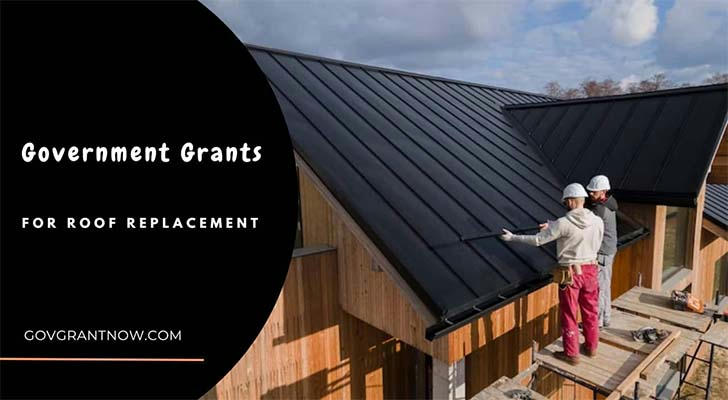How Seniors Can Replace Their Roofs Through Government Assistance
A worn-out roof can lead to a host of problems, including leaks, structural damage, and potential health hazards. For seniors, the cost of roof replacement can be financially overwhelming. However, the U.S. government offers various assistance programs that can help eligible seniors reduce the financial burden of roof repairs. These programs are designed to ensure that older adults can live in safe, secure homes without the additional stress of unaffordable home maintenance costs. Below is a comprehensive guide to understanding these programs and how to apply for assistance.

1. Main Government Assistance Programs
(1) USDA Section 504 Home Repair Program
The U.S. Department of Agriculture (USDA) offers the Section 504 Home Repair Program, which is aimed specifically at helping low-income seniors in rural areas improve their housing conditions. This program provides both grants and loans to eligible homeowners.
• Grant of up to $7,500: This grant is available to seniors aged 62 and older who need assistance with removing health or safety hazards, such as replacing a damaged roof.
• Low-Interest Loan of up to $20,000: This loan has an interest rate of just 1% and can be repaid over 20 years. It can be used for various home repairs, including roof replacement.
Eligibility: To qualify, applicants must be at least 62 years old, live in a rural area, and meet income requirements. Additionally, the roof must pose a safety risk or be damaged to a degree that affects the livability of the home.
Why It Matters: This program is especially beneficial for low-income seniors in rural areas who might struggle to afford roof replacement without help. It can help maintain the integrity of their homes, ensuring they are safe from weather damage and other health risks associated with deteriorating roofs.
Application Process: Seniors can apply online via the USDA website, or by contacting local housing management agencies for guidance and application forms.
(2) HUD Home Repair Assistance
The U.S. Department of Housing and Urban Development (HUD) provides funding to local governments through Community Development Block Grants (CDBG) and the HOME Program, which can be used for a variety of home repairs, including roof replacement. Local governments are responsible for administering these funds and may offer roof replacement assistance to seniors.
Why It Matters: These programs are vital for those living in urban areas who may not qualify for USDA support. By leveraging local HUD funding, seniors can access grants or loans to help them maintain safe living conditions.
Application Process: Seniors should contact their local HUD office or housing management agency to inquire about available funding in their area.
(3) Low-Income Energy Assistance Program (LIHEAP)
While primarily designed to help seniors pay their heating and cooling bills, some states offer LIHEAP funding that can be used to replace roofs that help improve energy efficiency. A new energy-efficient roof not only prevents leaks but can also reduce heating and cooling costs in the long term.
Why It Matters: An energy-efficient roof can reduce future energy costs, making this option even more valuable for seniors on fixed incomes.
Application Process: Seniors should visit the LIHEAP website or consult local government agencies to see if this option is available in their area.
2. Steps to Apply for Assistance
Step 1: Verify Eligibility
• Age Requirement: Typically 62 years and older.
• Residency: Some programs, like USDA, are available to seniors in rural areas, while others, like HUD, may apply to urban residents as well.
• Income Level: Seniors must meet specific low-income standards.
• Home Condition: The roof must be unsafe or in need of replacement due to significant damage or other health/safety concerns.
Step 2: Gather Required Documentation
• Proof of Identity: Social Security number, ID, or passport.
• Proof of Income: Social Security, pension, or other financial documentation.
• Housing Documentation: Property deeds or rental agreements.
• Roof Condition: Photos or an assessment report of roof damage.
Step 3: Submit Your Application
• Applications can be submitted online or by contacting local housing agencies. Be prepared to wait for an approval process that may take several weeks to a few months.
Step 4: Work with a Contractor
• After approval, the government may assign a contractor to replace the roof or allow seniors to choose from a list of approved contractors. Ensure the contractor follows the program's guidelines to ensure funds are properly allocated.
3. Additional Resources to Lower Roof Replacement Costs
Beyond government assistance, there are additional avenues seniors can explore:
• Non-Profit Organizations: Organizations like Habitat for Humanity often assist with home repairs for low-income seniors.
• Religious and Charitable Organizations: Some local churches or community groups provide financial assistance for home repairs, including roofs.
• State and Local Programs: Various state governments and local municipalities offer additional grants and loans for seniors needing home repairs, including roof replacements. Contact local housing departments for more details.
4. Conclusion
Replacing a damaged roof is critical for ensuring the safety and comfort of a home, especially for seniors. With the variety of government programs available, seniors can find financial relief through grants and low-interest loans that make the process more affordable. These programs help ensure that older adults live in safe, secure homes without the stress of costly repairs.
To explore further details about the Section 504 loan and grant program, visit USDA Section 504 Loans and Grants.
